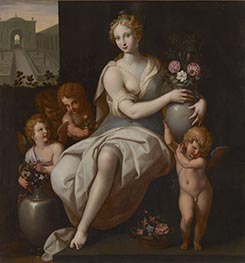Ambroise Dubois Giclée Fine Art Prints
c.1542–c.1614
French Mannerist Painter
Ambroise Dubois, born in Antwerp sometime between 1542 and 1570, is one of those elusive figures whose work rests at the intersection of Flemish roots and French Renaissance grandeur. While the details of his early life are sparse, Dubois emerged as a key painter of the second School of Fontainebleau - a movement that sought to infuse French art with the elegance and sophistication of Italian Mannerism. He followed in the footsteps of Niccolò dell'Abbate and Francesco Primaticcio, two giants who brought the Italian Renaissance to France. Dubois’s own contribution, however, lies in his ability to blend these influences with the stark, expressive qualities of his Flemish heritage.
By the early 1600s, Dubois had carved out a prestigious role as a court painter. In 1606, he was appointed to work for none other than Marie de Médicis, the powerful Queen of France. His most notable project at this time was the decoration of the Queen's Cabinet in the Château de Fontainebleau. Here, he depicted scenes from "Tancred and Clorinda," an epic narrative rooted in the romance and heroism of Torquato Tasso's "Gerusalemme Liberata". In these mythological scenes, Dubois demonstrated his flair for drama and movement - qualities that evoke the theatricality of the Italian masters, but with a Northern European edge.
Dubois's work often gravitated toward portraits and mythological themes. His portraiture was less concerned with the extravagant embellishments that characterize much of courtly painting, and instead sought to capture the individuality of his subjects. There is a tension in Dubois's figures - a sense that these are not just idealized figures but complex, perhaps even flawed, individuals. It’s in these subtleties that Dubois stands out, though his legacy remains overshadowed by more flamboyant contemporaries.
Fontainebleau was where Dubois truly made his mark, and it was here that his life came to a close sometime between 1614 and 1619. Though he never quite reached the heights of fame that some of his peers enjoyed, Dubois remains an essential part of the tapestry of French art during the reign of Henry IV and Marie de Médicis. His work, blending myth with human emotion, serves as a quiet testament to the power of narrative painting in an age of political and artistic transformation. And while many of his works may be tucked away in the corners of history, they continue to offer glimpses of a painter who knew how to navigate the complexities of both courtly life and mythological storytelling.
By the early 1600s, Dubois had carved out a prestigious role as a court painter. In 1606, he was appointed to work for none other than Marie de Médicis, the powerful Queen of France. His most notable project at this time was the decoration of the Queen's Cabinet in the Château de Fontainebleau. Here, he depicted scenes from "Tancred and Clorinda," an epic narrative rooted in the romance and heroism of Torquato Tasso's "Gerusalemme Liberata". In these mythological scenes, Dubois demonstrated his flair for drama and movement - qualities that evoke the theatricality of the Italian masters, but with a Northern European edge.
Dubois's work often gravitated toward portraits and mythological themes. His portraiture was less concerned with the extravagant embellishments that characterize much of courtly painting, and instead sought to capture the individuality of his subjects. There is a tension in Dubois's figures - a sense that these are not just idealized figures but complex, perhaps even flawed, individuals. It’s in these subtleties that Dubois stands out, though his legacy remains overshadowed by more flamboyant contemporaries.
Fontainebleau was where Dubois truly made his mark, and it was here that his life came to a close sometime between 1614 and 1619. Though he never quite reached the heights of fame that some of his peers enjoyed, Dubois remains an essential part of the tapestry of French art during the reign of Henry IV and Marie de Médicis. His work, blending myth with human emotion, serves as a quiet testament to the power of narrative painting in an age of political and artistic transformation. And while many of his works may be tucked away in the corners of history, they continue to offer glimpses of a painter who knew how to navigate the complexities of both courtly life and mythological storytelling.
1 Ambroise Dubois Artworks

Giclée Canvas Print
$87.04
$87.04
SKU: 19012-DIS
Ambroise Dubois
Original Size:148 x 137 cm
Fuji Art Museum, Tokyo, Japan
Ambroise Dubois
Original Size:148 x 137 cm
Fuji Art Museum, Tokyo, Japan